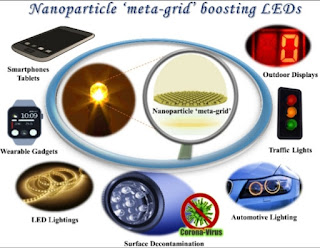IIT Guwahati, in collaboration with Imperial College London, develops nanoparticle ‘meta-grid’ to boost the overall performance of LEDs, The “meta-grid” could improve the performance of light-emitting diodes (LEDs) by making them brighter, energy-efficient and durable





GUWAHATI, 7th August 2020: Researchers from the Indian Institute of Technology Guwahati, India, and Imperial College London, UK, have developed a tailored ‘meta-grid’ of nanoparticles that could make light-emitting diodes (LEDs) brighter, energy-efficient and durable. ‘Meta-grid’ or ‘metamaterial grid’ is a specifically patterned array (grid) of nanoparticles acting as metamaterials, capable of exhibiting extraordinary optical properties.
In today’s world, LEDs are deployed almost everywhere — from traffic lights to backlighting for electronic displays, smartphones, large billboards, decorative lightings, water purification, and decontamination of infected surfaces. An increase in LED light output would significantly reduce energy needs on a large scale, and therefore, will contribute towards curbing global warming and climate change.
Over the years, a significant research drive towards this objective is in exploring new materials for LED-chip encapsulation, mostly by deploying either higher refractive index glasses or epoxy materials incorporated with filler powders or nanoparticle-loaded-epoxy or engineered epoxy resins, etc. However, these techniques either makes the LED chips bulkier or their fabrication becomes more challenging and less economically viable for mass production.
Towards this goal, Dr. Debabrata Sikdar, Assistant Professor, from IIT Guwahati, along with Prof. Sir John B. Pendry and Prof. Alexei A. Kornyshev from Imperial College London, has developed a nanoparticle ‘meta-grid’, which needs to be placed at an appropriate location within the epoxy casing of the LEDs, for improving light output from LEDs. A ‘meta-grid’ is a specially-designed, optimised, two-dimensional array of specific nanoparticles, of size much smaller than the wavelength of light.
The findings have been recently published in Light: Science & Applications journal of the Nature Publishing Group. While prescribing minimal changes to the manufacturing process, the research team has developed this novel scheme of boosting transmission of light generated inside an LED chip across the LED-chip/encapsulant interface. This is achieved by reducing the Fresnel reflection loss at the chip/encapsulant interface, within a fixed photon escape cone, based on tuning the destructive interference phenomena with help of the ‘meta-grid’.
The technique has revealed optimal design parameters for such meta-grids to produce greater light output over any narrow/broadband emission spectrum, besides boosting LEDs’ lifetime by eliminating heating of the chip from unwanted reflections within the chip.
The technique is deployable by itself or in combination with other existing techniques applied for increasing LED’s efficiency. The entire original theoretical framework needed for the invention has been developed in-house and is rigorously tested against standard commercial simulation tools. The research team plans to fabricate a prototype device within one year and corroborate their theoretical predictions with experiments.
The theoretical models, developed by Dr. Sikdar and his collaborators, allow finding out the optimal conditions for the design of the nanoparticle ‘meta-grid’ layer. Material and composition of nanoparticles and parameters, such as their sizes, average interparticle spacing and the distance from the surface of the LED chip, are optimised to achieve the maximum enhancement in light extraction from the LED chip into its encapsulating casing, over any emission spectral range of a typical LED.
Speaking about the merits of their ‘meta-grid’ scheme for LED light enhancement, Dr. Debabrata Sikdar, Assistant Professor, Department of Electronics and Electrical Engineering, IIT Guwahati, said, “With the continuous advancement in nanofabrication technology, it is now possible to fabricate metallic nanoparticles which are mostly monodisperse or having a very narrow spread. Still, there could always be some randomness in particle size and/or position, flatness of grid, and variation in refractive index due to fabrication error or material defects, which are unavoidable. Effects from most of these inaccuracies can be estimated from our tolerance study and it has shown the robustness of our scheme”.
Dr. Sikdar further added, “In this invention, the effects of the ‘meta-grid’ on the standard commercial LEDs, based on group III–V materials are demonstrated. However, the proposed concept of enhancing light transmission from an emissive layer to its encapsulant casing can be extended to other types of light emitting devices hosting an emissive-layer/encapsulant interface. Generally, our nanoparticle ‘meta-grid’ scheme for enhanced light extraction could potentially cater to a wider range of optical gadgets, not just semiconductor LEDs.”
Speaking about the work, Prof. Alexei A. Kornyshev, Department of Chemistry, Imperial College London, stated, “There could be different engineering solutions for the meta-grids in the LED-chips. One of them would be to use drying-mediated self-assembly of nanoparticles, e.g. made of silver or alternative less-lossy plasmonic materials capped with appropriate ligands, to form free-standing the Sikdar–Premaratne–Cheng ‘plasmene’ sheets. Those nanoparticle monolayer sheets could be made stretchable for precise tuning of the interparticle separation and then stamped on the LED chip before the encapsulating casing is fabricated. The spacing between the ‘meta-grid’ and the LED chip surface can be controlled via the thickness of the plasmene’s substrate”.
Talking about their work, Prof. Sir John B. Pendry, Department of Physics, Imperial College London, said, “The simplicity of the proposed scheme and the clear physics underpinning it should make it robust and, hopefully, easily adaptable to the existing LED manufacturing process. It is obvious that with larger light extraction efficiency, LEDs will provide greater energy savings as well as longer lifetimes of the devices”.
The research team believes that the work will definitely have a global impact on the versatile LED based applications and their multi-billion-dollar market worldwide.













